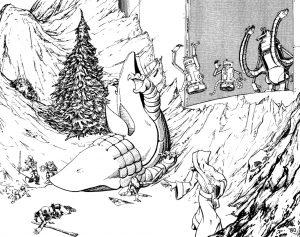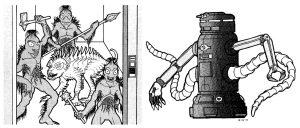I saw my first space wizard in 1977. After seeing that first Jedi, I knew that fantasy and science fiction had a place together.
Gary Gygax also knew that fantasy and science fiction have a place together. In fact, one year before Star Wars was released, Gygax mashed science fiction elements into his Castle Greyhawk Dungeons and Dragons setting and playtested it as a tournament scenario at Origins II, a precursor to the large cons us nerds enjoy today.
Then Gygax took that material a step forward in 1980 with Expedition to the Barrier Peaks, a D&D module he presented as “an exciting insertion into your campaign and as a primer on how to combine ‘science’ into your fantasy roleplaying.”

Having laser guns in the same setting with magic takes some suspension of disbelief…er, you know, even more suspension of disbelief than explaining laser guns or magic on their own.
But like one of those COEXIST bumper stickers you’ll see today, it wasn’t a big deal in the 1970s to blend fantasy and science fiction, or even horror and pulp adventure, unlike today where the genres are niched and driven by market differentiation.
There was a freedom to go “gonzo” back in the day and that is exactly what Gary Gygax did with Expedition to the Barrier Peaks. In addition, D&D adventures from yesteryear weren’t concerned with player agency or motivation, nor with filling in story gaps. Like most modules of that era, Barrier Peaks only had the thinnest outline of a plot. Instead, the plot was kept simple: The party was recruited to travel to the Barrier Peaks as it had recently been attacked by strange and unearthly monsters that defied explanation. And they must be vanquished!
Those monsters were coming from a strange dungeon made of impenetrable metal. How did it get there? Who cares!?! Adventurers must enter this strange dungeon and find out what the banana crackers was going on!
So, ironically, Barrier Peaks is actually a very fantasy-traditional dungeon crawl, the difference being that the dungeon is made of a downed spaceship and not shaped by Dwarven stonecutters. This spaceship “dungeon” of Barrier Peaks is large, multi-leveled, and filled with a variety of environments, which allowed the imagination of Gary Gygax go wild as he created encounters.
Those encounters included alien new monsters like the vegepygmies, a dim-witted vegetable-like creature that craves meat and reproduces by mold buds or something. Gosh, I don’t know! I just know that vegpymies were weird and alien and so very much fit the vibe of the Barrier Peaks.

There were also psionic mind flayers and froghemoths, brutal tentacle creatures that would be right at home on Dagobah. And there were robots, so many robots. Barrier Peaks wasn’t concerned with making sense; it was only concerned with being fun, so Gygax threw everything in the Multiverse at players.
A big part of this fun was the “magic items” of Barrier Peaks, which were technological artifacts that came with a series of flowcharts to help players use them safely. Who said Gary Gygax couldn’t be thoughtful?
There was power armor, laser pistols, chain swords, motorized sleds, jet packs, and other thingamajigs. And the adventure didn’t lack puzzles either. There were all sorts of color-coded security cards that were used to open different blast doors.
Each of these “artifacts” and the alien monsters were wildly illustrated. In fact, there were over 60 illustrations in S3 Expedition to the Barrier Peaks (‘S’ stood for special module and followed Tomb of Horrors and White Plume Mountain). The art was by Erol Otus, an artist that could make a product like Barrier Peaks come alive.
Some thought the inclusion of science fiction into the fantasy of D&D was too “silly.” I loved it. I can recall thinking as a kid that Expedition to the Barrier Peaks included all the nerdy things I loved in one big fun playground.

Many agree with me. Paizo’s Pathfinder based an entire region of their game world Golarion on Barrier Peaks and wrote the Adventure Path Iron Gods as a homage. Iron Gods features a backwater fantasy town with an adjacent crashed ancient starship, ensuring that the legacy of Barrier Peaks will live on.
Paizo has also taken it a step further in the creation of their Starfinder RPG, an entire game devoted to the beautiful blend of science fiction and fantasy. I now play a regular Starfinder campaign with my daughter and nephews.
Expedition to the Barrier Peaks perfectly captured the fun that could be had by mixing fantasy and science fiction, and for that reason, it’s a D&D classic. There is something to be said about flipping through these classic D&D modules. If you are looking for a copy, try Noble Knight. They specialize in out of print classics and you can find their Barrier Peaks page here.

